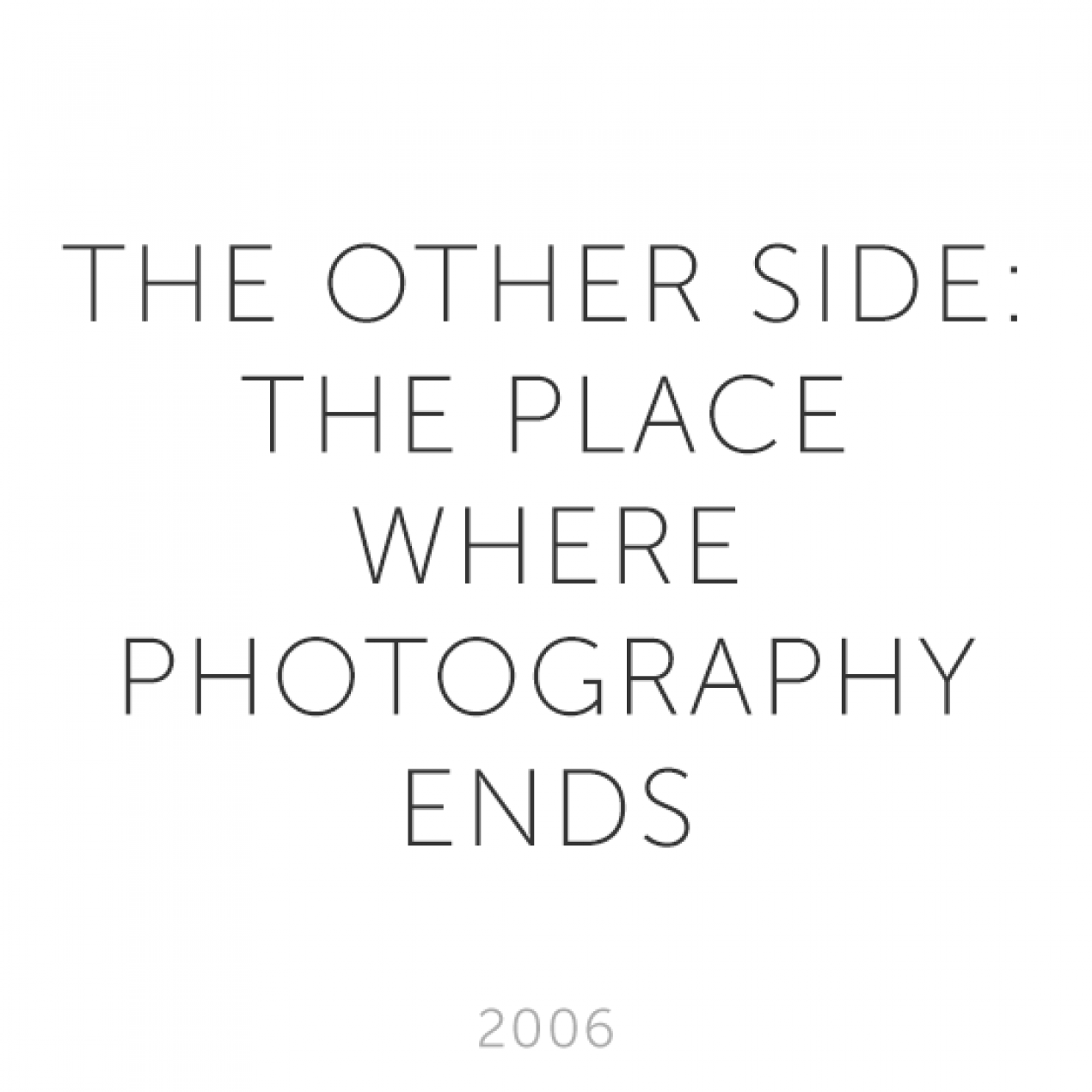* The article, “Öteki Yüz: (The Other Face:) Fotografinin Bittiği Yer / The Place Where Photography Ends” was
published in rh+ sanart, issue 34 of Turkey’s Plastic Arts Magazine in November 2006.
The development process of photography involves two important periods: Someone said; “Depuis ce jour, la peinture est mort / As of today painting is dead.” The first is the period that lasted until these exaggerated remarks of the painter Paul Delarouche on August 19, 1839, during the official announcement of the daguerrotype imaging technology to the world; the other is the new period that started with Daguerre and lasts until today. In the context of the developments between the beginning and the present, the interaction of painting and photography, is the belief of an important fraction that would make William Turner say “I am pleased that my period fell behind”. This is the idea that photography will replace painting and the debates on whether or not photography is art, the manifestos put forward on those that are forbidden and not forbidden, are only a few of the main headings we have struggled with and debated over.
In the 19th century, as a brand-new tool of expression and as a tool initially far from any major claims to being art, the sole purpose of earliest practitioners of photography, presented to the world as an image recording, device, was the objective and accurate recording of the subjects they were working on, rather than artistic expression. Photography, which emerged as a ready-made image, could not profess to be art, as it did not have the sub-structure of form and meaning development that has been manipulated finely in the direction of social value judgments throughout history, unlike other plastic arts. However, the fact is that the machine created by technology has finally condemned the naturalistic representation in painting, which was trying to objectively examine the truth that can be seen, and coinciding with the same era, to disappear. Maybe photography was developed to perform this function much better than the painting.
Among the new art movements that emerged at the beginning of the 20th century, photography was an instrument that represents the development of technology and has responded to objective, functional and clear expressions of machine aesthetics that determine on the one hand a new visual language and on the other hand has underpinned the beginning of a process leading to big changes in the stylistic language of the art of painting. The new abstract expressionism of painting influenced photography in a short time. In this interaction, new possibilities for visual expression and experiments in line with the other side of photography were produced.
Even though our country was in the same century this period is a literal dark period for photography as a movement for obvious reasons.
It is a process that begins with the Republic, when the use of photography in visual communication systems and finding its field of practice, gaining wide currency, creating a language of communication fulfilling the needs of the contemporary society and transition from verbal-based communication to visual-based communication are realized in our country. The reality of village, which determined the general tendency at the end of the 50’s and at the beginning of the 60’s, turned into the big city reality until 1970’s and to the suburban reality between 1970-80. The social realist period is the period between the 60s and the 80s took advantage of traditional and regional cultural heritage by using a language closely attached to national traditions and culture and by prioritizing subjective problems and keeping out of the western artistic trends. This period, in which the more, well known side of photography is presented and can be directly linked to the photography, documentary and/or documentary photography and photojournalism movements.
The results of the negative impact the passive structure of the hard-liner attitude of the period had on the developing dynamics delayed transition to the contemporary art scene and the interdisciplinary flow of information. Unlike many other concepts and disciplines that were given numerous definitions, interpretations, and evaluations (both conventional and non-conventional) in the transition to the contemporary order, photography could not break out of the naturalist tradition based on objective reality and put forward by the better-known side of photography, until the 80s.
The post-1980s was a time of rebellion, an utter revolt when universal cultural heritage was utilized, universal common values were adhered to, common language was used, and art categories of the West were observed. Artists who used photography in this period, a time when the contemporary art scene was being prepared for photography, stood on rather different grounds than those photographers who capture images of the perceived. By the distinction observed by Victor Burgin in his article “Photography Practice and Art Theory”, the difference between finding meaning and creating meaning, can be explained as, again in his own words, the most important difference between artists who use the opportunities of photographers and the artists who see photography as an infrastructure and who produce work in this vein. Artists who produce work based on photography by this distinction can be attributed to the subjective photography, surrealistic photography, experimental photography and conceptual photography movements.
In Turkey, since the 1980s the work that emerges to the foreground at different levels within the contemporary art scene, are the approaches directed towards expanding the boundaries of what can be done with the medium of photography. It can be said that under our country’s conditions work based on photography are realized in two different planes: In the first plane photography surpassed the objectivity of the objective image, and used all technical, aesthetic, semantic and pragmatic opportunities of the tool as well as of other plastic arts. So, objective reality was idealized and an attempt was made to re-model in an intellectual environment. Here the aim is how reality has been imagined is aimed. The results obtained from everyday life form the product of the purpose. There is such a self-observation in this that man begins to question the meaning – or lack thereof – of his actions and put their consciousness in place of an impressionistic view. This plane is the abstract expressionistic. Whereas, in the second plane can be called, the conceptual plane, based on the concept that the objective reality is surpassed through use of abstract concepts and the forms assumed in the objective reality. Here the aim is not to reach photography, but to produce photography-based work by using it as a tool in the act of creation.
In the general current framework of photography, it is as if man is forced to look at a visual image from a certain angle. Whereas in photography-based studies in the contemporary art environment, other ways to look at the image are brought forward and their discovery even supported. Apart from the usual rules of reading, it offers an insight to reading from every direction. The opportunity is provided for the observer to read in the direction of their own knowledge.
As a person who contributed to and accelerated the establishment of the theory- and practice-oriented infrastructure of the era that triggered the 1980s period, I have combined images of the stuff of dreams or from subconscious impulse instead of capturing the photograph of the moment. To find meaning in the reality we live in, I have always tried to observe the moment so I can then create and reflect on its own subjective reality as a fluid way of facing the other reality, just as it is in the theater. It is based on a cause that seems unimportant: First, all I wanted was freedom; as Man Ray also said, a freedom where everything that is forbidden is done, a freedom that will show insight to another inner reality beyond the description of everyday life, that will allow me to live the past-present and tomorrow at the same time. To this end, I tried to evaluate the collage technique as a creative, functional and formative process for achieving a new visual explanation by using familiar materials from separate roots and logic processes. In my photo-plastic work created after the period, I directed the perceived objective reality to abstract expressionist works until 1989.
At the point reached today, photography is said to have died. In the present century, the thought that we witness the commencement of a new era, the post-photography era has started to become widespread for the pre-photography and post-photography emphasized in his book titled “Into the Image: Culture and Politics in the Field of Vision”, see what Kevin Robins says:
“From such a perspective, old technologies (chemical and optical) have come to seem restrictive and impoverished, whilst the new electronic technologies promise to inaugurate an era of almost unbounded freedom and flexibility in the creation of images. There is the sense that photography was constrained by its inherent automatism and realism, that is to say, by its essentially passive nature; that the imagination of photographers was restricted because they could aspire to be no more than the mere recorders of reality. In the future, it is said, the enhanced ability to process and manipulate images will give the post-photographer greater ‘control’, while the capacity to generate (virtual) images through computers, and thereby to make images independent of referents in ‘the real world’, will offer greater ‘freedom’ to the post-photographic imagination.”
October 2006







